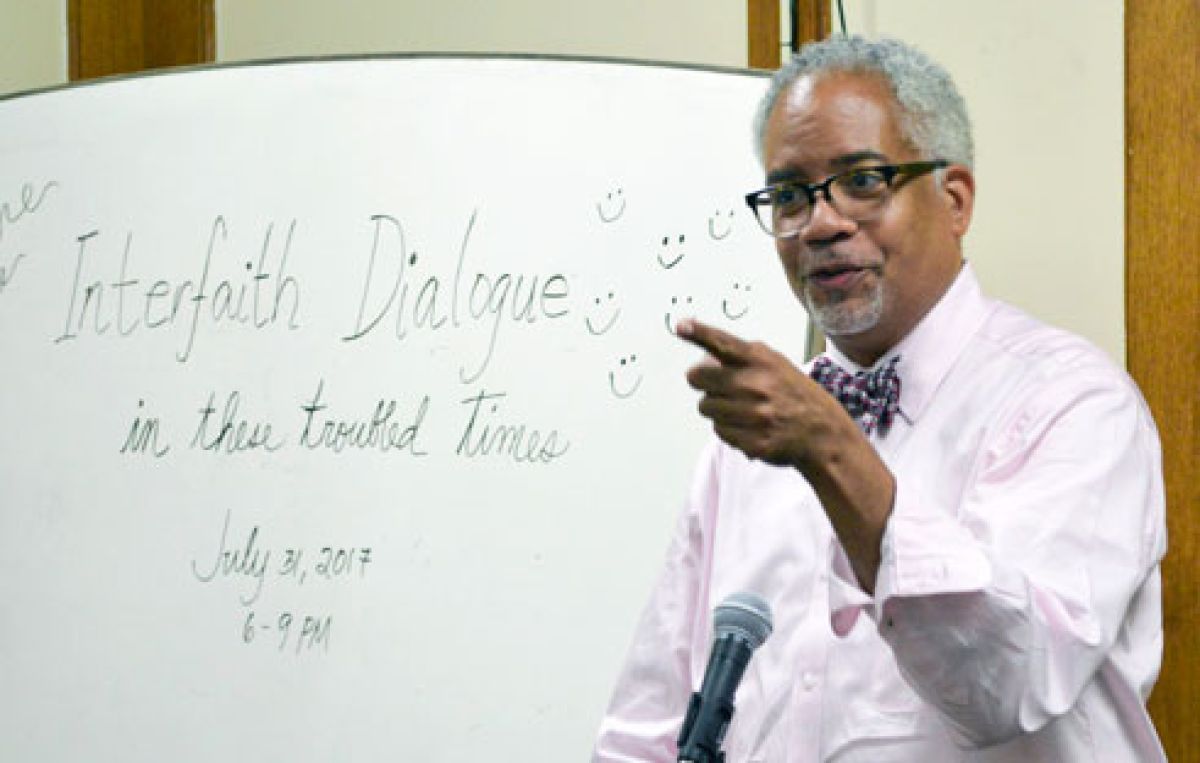Interfaith: It’s all about love and understanding and community service

NEW YORK CITY – In the celebrated Oak Room, a multi-media classroom for graduate studies at the Unification Theological Seminary (UTS), interfaith inched up into a more profound and pragmatic meaning during a forum on “Interfaith Dialogue in these troubled times” on Monday, July 31st.
The speakers, representing academia, community service, and church ministry articulated how interfaith, both in reason and action, could provide the platform for peace in this era of local and global divide and chaos.
Photo: Rev Michael Elam, representing church ministry, addresses the group.
UTS president Dr. Hugh Spurgin was delighted to welcome the speakers and guests, and asked the question: “How do we survive in these troubled times?” Indeed, “having an interfaith mindset of inclusivity and mindfulness of others is key,” he said. The three-hour event thus began and proved to be not only informative but inspiring as well.
New York is unique because we are a global city. I find it incredibly moving that through a community, we are able to heal and serve. I believe this is how we can survive in these troubled times, to become a whole community with many different faiths.”Peter Gudaitis, Executive Director, New York Disaster Interfaith Services (NYDIS)
Interfaith means to love, be understood and be in a community
Peter Gudaitis, executive director of the New York Disaster Interfaith Services (NYDIS), said we needed to be more ambitious rather than be stuck with the thought that interfaith is about religious tolerance. “I want to be understood, not tolerated, to be loved and to be in community with other people.”
Gudaitis started his work in in service to others as a college student with a conservative Anglo-Catholic background. He said that he was tremendously moved by his community service work in the aftermath of the horrific 9/11 attacks on the World Trade Center in 2001. “It turned out that we can only do our work together – provide emotional, spiritual, and economic help to those affected. We had to work with other people with different faith traditions in order to be effective.”
Gudaitis said that to have a community means not only to understand one another, but in fact to establish relationships close to being “friends or family,” in order to be effective. “New York is unique because we are a global city. I find it incredibly moving that through a community, we are able to heal and serve. I believe this is how we can survive in these troubled times, to become a whole community with many different faiths.”
Black American Church must uncover its own spirituality
Recently ordained interfaith minister Rev. Michael Elam spoke of the uniqueness of the African-American faith experience which he proposes is an absolute distinct from the rest of the world. “There is no other experience as the Black Church in America. It wasn’t organic. It was forced.”
Check-out the Facebook live video posted by Dr. Idris Ena Kone, UTS Director of student life.
Explaining the experience of imposing Catholicism and Protestantism on slavery, Elam said that this was how the African-American church was founded. “It was not even about putting a square peg on a round whole. It was molding the minds of Blacks to fit into religion,” he said.
Elam shared his personal story about how he became a shaman and said that his ministry centers on shamanism to “uncover the Black Church.” Shamanism is an ancient spiritual practice and a way of life in many parts of Africa and Asia.
UTS student Dasse Dearra concurred with Rev. Elam’s points of view and said that in his home country of Mali, spiritual and cultural traditions are rich and diverse and were stronger than any religious practice.
All religions point to God as love and justice
Dr. Andrew Wilson, UTS professor of Scriptural Studies, had said earlier in the evening that there is a tremendous overlap of religions, and that actually, “When you look at the totality of belief there is so much that can unite us as believers, whether we are Muslim, Christian, Buddhist, Jewish, whatever.
Photo: Dr. Andrew Wilson, representing academia, addresses the group.
Wilson is the author of the World Scriptures: A Comparative Anthology of Sacred Texts, which is a compilation of the major texts and themes espoused by Judaism, Christianity, Islam, Buddhism, Bahai, and Confucianism. He stated that the mindset of “tribal identity” where people regard their religion as the best, is the beginning of misunderstanding and chaos.
“God is infinite, and God is like a diamond with a million facets, and each religion is like catching one facet of that God, and bringing it out in all of its beauty. But, there are other facets that we don’t see, that we can learn from, that we can appreciate the beauty and glory of the multitude of human race that God created.”
A new level of understanding and inspiration
UTS recruitment director Joy Theriot managed the enriching open forum and said that to her, interfaith simply means love and service to all of humanity.
The UTS Recruitment department put together the Interfaith Dialogue which was attended by 35 guests.
Photo: Participants, organizers and speakers. Middle row (from left): UTS recruitment director, Mrs. Joy Theriot, UTS President, Dr. Hugh D. Spurgin, Executive Director of NYDIS, Mr. Peter Gudaitis, UTS Professor, Dr. Andrew Wilson, Rev. Michael Elam.
Richard Punzalan, a guest, said the forum was fun and insightful and gave him the inspiration that a better, more peaceful world could be built through interfaith cooperation.
Vanette Colmenares, who will be a new student at UTS for the fall semester, said she was happy to have attended the forum. “I reached a higher level of understanding about interfaith. I was truly inspired.





